Editorial Note: This article was originally published in the January 2019 print issue of Roadracing World & Motorcycle Technology.
Roadracing World & Motorcycle Technology is THE definitive source for motorcycle racing, riding, and tech information.
SUBSCRIBE NOW FOR INSTANT DIGITAL ACCESS!
PREVIEW the July 2019 Issue
Roadracing World & Motorcycle Technology magazine is available in print and digital formats.
Log in or subscribe HERE.
Or call (909) 654-4779, 9:00 a.m. – 5:00 p.m. Pacific Time, Monday through Friday.
Visit www.roadracingworld.com daily for breaking news and events.
https://www.facebook.com/roadracingworld
https://twitter.com@roadracingworld
https://instagram.com@roadracing_world

By Chris Ulrich
There is something to be said about dedicated motorcyclists
designing, building, and developing motorcycles. The excitement of riding a
motorcycle is easy to describe to somebody who has done it, but hard to
transmit to most normal people: They just won’t get it unless they’ve ridden a
bike. KTM’s engineering staff is fully populated by riders, and that riding
culture comes through loud and clear with the 790 Duke. It is a case study in
building a motorcycle that is powerful, compact, and lightweight with sharp
handling, so it’s no wonder that KTM nicknamed it The Scalpel!
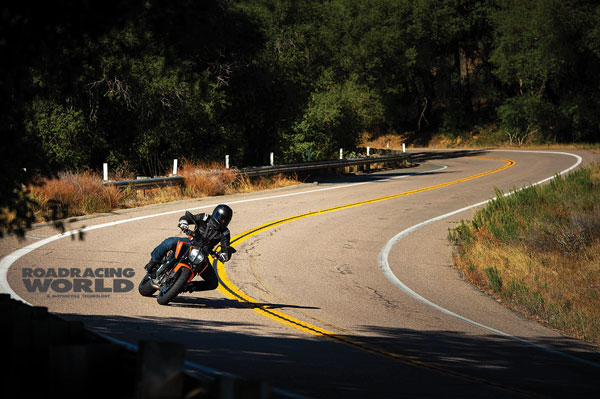
(Above) Roadracing World’s Chris Ulrich on the 2019 KTM 790 Duke, a middleweight streetbike combining a great power-to-weight ratio and sharp handling.
I could already tell it was going to be a good day when I clicked
into second gear and pulled out of the parking lot at the start of the official
intro for the KTM 790 Duke. The engine spun up through the rpm and ripped
through the gears effortlessly, and the day had just begun. We ventured out on
a route that took us from the Southern California beach town of Encinitas and
down the coast, then headed east towards Mount Palomar before heading back
toward the ocean. But it didn’t take a 150-mile loop on some of the best roads
Southern California has to offer for me to figure out that this KTM is a
ripping middleweight that will make anybody with a pulse want to get out and
ride!
The performance of the 799cc Parallel Twin engine really stood
out as we rolled down Pacific Coast Highway. Riding from stoplight to
stoplight, I couldn’t help launching off the line at each green and blasting
through the first three gears, before backing off to stay out of
speed-limit-related trouble. The 790 Duke gains rpm like a Superbike with a
lightweight kit stator, so quickly in fact that it gives the seat of the pants
impression of accelerating harder than its big brother, the 1290 SuperDuke R.
It’s a real-world example of a good power-to-weight ratio in two-wheeled
action!

(Above) Ulrich found the KTM also entertaining on the racetrack, although if we owned it, we’d upgrade the stock tires and front suspension.
The real fun began as we headed down Highland Valley Road and
made our way toward the east grade of Mount Palomar. Highland Valley Road is
tight, twisty and slick, and the 790 Duke showed its handling prowess without
making me take risks on the road. It delivers light steering and easy turn-in,
yet is stable at the apex, and finishes the corner well. The engine pulled out
of slow, second-gear corners effortlessly, and the 790 Duke also handled
faster, sweeping corners. I was so comfortable with the bike as we climbed the
hill that I kept catching myself going faster than anybody really should on an
open public road.
Carving up the twisty roads gave me a good idea of the 790 Duke’s
potential, but, as we always do, we took the 790 Duke out to the racetrack to
really test its limits. For that, I headed to a Fastrack Riders event at Auto
Club Speedway, which features a road course that is flat and a little bumpy,
but which also has a good mix of high- and low-speed corners that allow a rider
to really get a good idea of a bike’s capabilities.
Before getting into the details, let me say that the KTM 790 Duke
is fun to ride on the track. Not in a holy-smokes, rip-your-arms-out power-wheelie way. But in an
instant-power-across-a-broad-rpm-range way. The 435-degree firing order spreads
out the power pulses, delivering lots of tractable power from 4,000 rpm to
around 9,500 rpm. The power delivery is so smooth that I was able to turn off
the traction control for racetrack use—even with the standard tires—without any
drama. Accelerating out of the last corner and down the front straight at Auto
Club Speedway, the 790 gains rpm so quickly that I hit the rev limiter before I
knew it, and had to start anticipating my shift points. This is not a typical
middleweight!
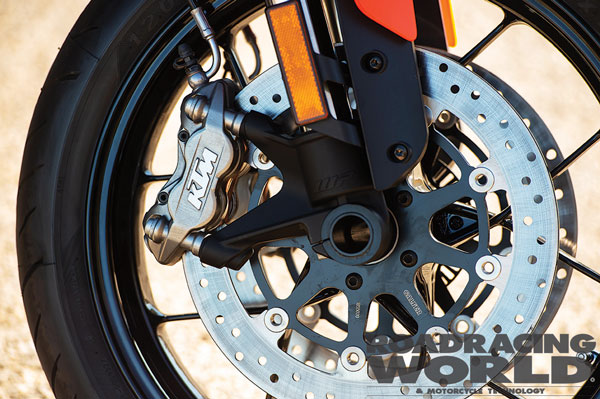
(Above) The 790 Duke’s floating front discs with radial-mount calipers.
On the chassis side, the non-adjustable WP forks have relatively
lightweight springs biased toward street comfort, and they bottomed out during
very heavy, straight-line braking. When they weren’t down on the stops, the
forks offered reasonable control and feedback, and the stock 790 Duke was less
prone to tucking the front than its 1290 big brother, which may be due to what
feels like better weight distribution.
But this middleweight comes with a full selection of advanced
electronics. The combination of the Motor Slip Regulation engine-braking
control system, the Quickshifter+ system’s auto-blip downshifting capability,
and the slip-assist back-torque-limiting clutch system improved braking
stability and helped keep the rear wheel in line at corner entry, even when the
front forks were on the bottom of their travel. Coming off the brakes and
turning into the corner is one of the KTM’s real strengths: The Parallel Twin
engine is light and compact, with the cylinders positioned nicely up front,
which reduces turning effort.
Once I was on my knee at the corner apex, the 790 Duke had good
feel and still finished the corner, even when I reached the traction limits of
the Maxxis Supermaxx ST front tire, buried the forks, and needed to correct
front-end slides. On exit, the 790 Duke rotated well through the middle of the
corner, which allowed me to get the gas open and drive out at full throttle.
And the rear tire gave decent feedback while spinning up during heavy
acceleration.
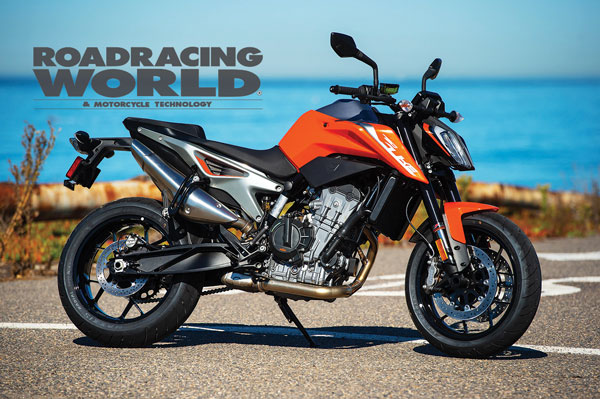
(Above) The 2019 KTM 790 Duke combines a steel-tube trellis-type frame and a die-cast aluminum-alloy swingarm with an open-lattice design.
Having said that, if I bought a 790 Duke and planned to do any
track riding with it at all, the first thing I would do is buy
higher-performance tires. The stock Maxxis tires may be designed for longevity
on the street, but just don’t deliver as much traction as I like. I’d upgrade
to a set of Dunlop Q3 or Q4 or Pirelli Rosso Corsa II tires for combined street
and track use, without needing to deal with tire warmers. I’d also upgrade to
heavier fork springs or just go straight to KTM’s optional WP Apex Pro 6500
track-use fork cartridge kit with springs.
My experience on the street and on the racetrack still made it
clear that the 790 Duke delivers, with good handling and a great engine,
setting a new performance standard in the middleweight Twins category. More
importantly, the bike is really fun to ride on the street and on the racetrack.
And after all, having fun is really why we all started riding motorcycles in
the first place!
Leading-Edge Tech In A Middleweight Package
The performance of the 790 Duke clearly illustrates how KTM has
established itself as one of the most progressive motorcycle companies in
business. Hard-core motorcycle enthusiasts are rampant in the ranks of KTM
employees, which may explain why the Austrian company keeps coming out with new
models that sell well. With the 790 Duke, KTM has positioned its latest naked
sportbike as a very capable bridge between the single-cylinder 390 and 690 Duke
models and the stomping twin-cylinder 1290cc Super Duke R.
It all comes down to packaging with the 790. KTM engineers wanted
to make the 790 as lightweight and compact as possible, so they chose to build
a 799cc DOHC Parallel Twin. The engine is so compact that it’s actually close
in overall dimensions to the company’s single-cylinder 390 engine. It’s
significantly smaller than the engines used in competing models like Yamaha’s
twin-cylinder FZ-07/MT-07 and three-cylinder FZ-09/MT-09 models, Suzuki’s
V-Twin SV650, and the BMW F-800 Inline Twin.
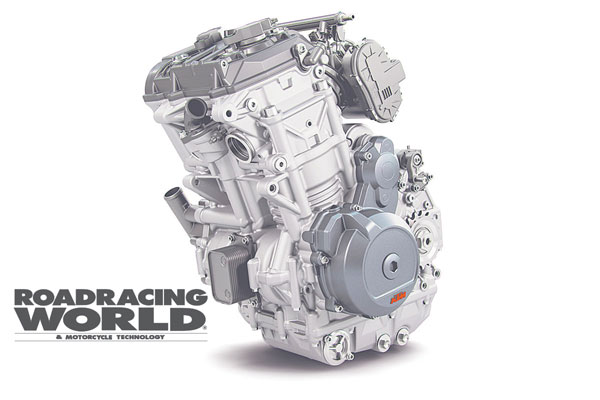
(Above) Assembled 790 engine.
To create the 790’s compact power unit, engineers started with
horizontally split cast engine cases cradling a one-piece forged crankshaft
with its rod journals offset 75-degrees. That allowed the engineers to set the
firing order at 435 degrees, producing the type of traction-enhancing
power-delivery characteristics typical of a V-Twin, but without the extra size
and weight of twice as many individual cylinders, cylinder heads, and valve
trains.
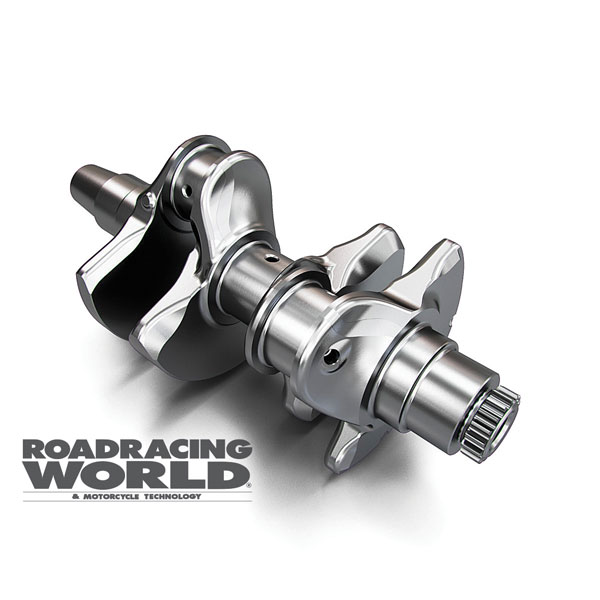
(Above) One-piece crankshaft with offset journals.
The engine has a bore and stroke of 88.0mm x 65.7mm and a
compression ratio of 12.7:1, and a set of lightweight forged pistons each ride
on a DLC-coated wrist pin carried by a fracture-split steel connecting rod.
Using the fracture-split technique for the connecting rod’s bolt-together
big-end creates a unique, more accurate and stronger self-indexing mating
surface, eliminating the need for locating dowels and thus reducing
reciprocating weight. The sleeveless aluminum cylinder bores are Nikasil plated
and the cylinder block features an open-deck design to help improve engine cooling.
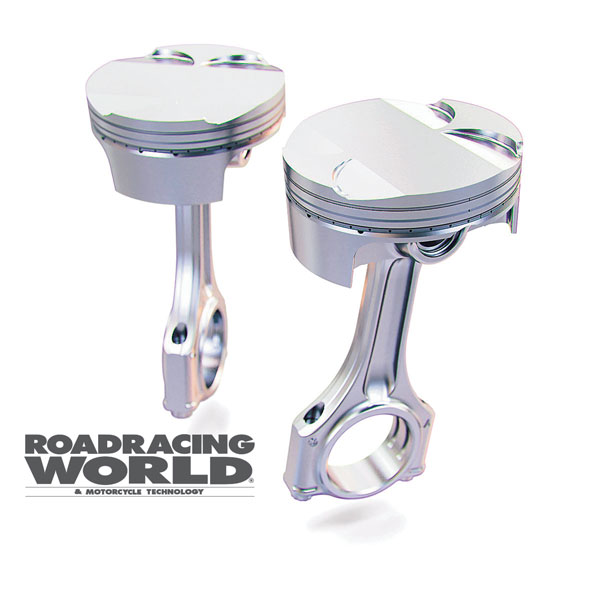
(Above) Forged pistons and fracture-split connecting rods.
Four steel valves per cylinder are actuated by a set of
chain-driven camshafts combined with DLC-coated finger followers. A gear-driven
secondary balancer shaft is positioned between (and driven off) the camshafts,
while the main balancing shaft is placed low in the engine and is driven off
the crankshaft. The end product is a compact engine that put out a measured
98.26 bhp at 9,570 rpm and 59.16 lbs.-ft. of torque at 7,800 rpm on the Attack
Tuning Center’s rear-wheel dynamometer.
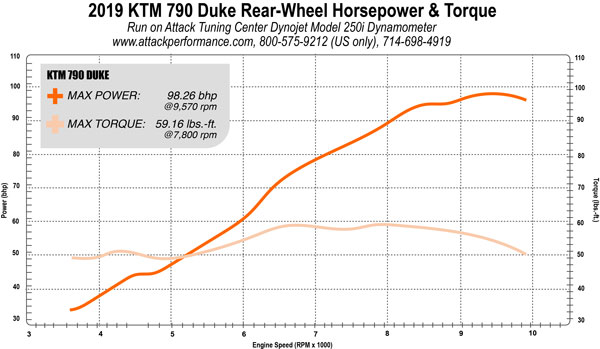
(Above) Attack Performance Center’s rear-wheel dyno showed the 790 Duke making 98.26 bhp at 9,570 rpm and 59.16 lbs.-ft. of torque at 7,800 rpm.
The engine is used as a stressed member in the chrome-moly
steel-tube trellis frame, helping reduce overall weight while also balancing
the flex characteristics of the chassis. The die-cast aluminum-alloy swingarm
is an open-lattice design that optimizes the balance between rigidity and flex.
Incorporating other parts of the chassis into the overall design, the
cast-aluminum sub-frame also houses the airbox, making room for increased
volume plus giving easier access to the air filter.
The advanced electronics suite includes lean-angle-sensitive
engine braking and traction control, controlled by a five-dimensional inertial
measurement unit (IMU) that reads yaw and roll movement and rate of change as
well as longitudinal, lateral, and vertical acceleration. The electronic Motor
Slip Regulation (MSR) system works with the power-assisted slipper clutch to
help prevent rear wheel hop and chatter on downshifts, and the MTC (Motorcycle
Traction Control) system comes with three pre-set levels and a configurable
fourth option. The Sport, Street and Rain settings offer differing levels of
traction control, with the Rain setting lowering the amount of power available;
all three MTC settings incorporate an anti-wheelie setting to help keep the
front wheel near the ground. The Track mode allows the rider to select five
additional levels of anti-spin that are less intrusive than the Sport setting
and to turn the anti-wheelie functionality off, and includes launch control for
racing starts. All the settings are easily accessed through the left handlebar
switch. The menu on the TFT dash is clear and making adjustments is fast and
easy. The dash also incorporates Bluetooth technology to allow the rider to
access music and manage phone calls—but why would they want to?

(Above) The KTM’s TFT dash is easier to read than most.
The 790 Duke follows the broad outlines of the other members of
the Duke family, with minimal bodywork, an upright seating position, and
tubular handlebars. Unlike more downmarket machines, the Dukes come with
more-sophisticated suspension components than usually seen in their market
segments. In this case, the 790 has non-adjustable 43 mm inverted WP forks with
progressive-rate springs that increase from 6Nm to 10Nm as they compress. A
single WP shock working with a progressive spring is located between the frame and
the swingarm. The forks feature an open-cartridge configuration with
compression and rebound functions located in separate fork legs, and also carry
progressive springs to help manage motion through a 5.5-inch stroke.

(Above) Exploded view of 790 Duke engine.
Front-wheel braking is handled by a pair of 300mm discs and
four-piston radial-mount calipers manufactured by JJuan, a Spanish brake
company. A single 240mm disc with a dual-piston caliper is used at the rear.
The bike comes with a Bosch ABS system which is remarkably sophisticated, offering
two different performance modes. The Cornering ABS setting is lean-sensitive,
assisting the rider in trail-braking into a corner by reducing the braking
force as lean angle increases. The Supermoto ABS setting allows the rider to
lock the rear wheel while maintaining ABS functionality at the front. In both
ABS modes, the intervention is smooth, not abrupt, giving the rider a natural,
comfortable feel at the brake lever.
The company claims a dry weight of 372.6 pounds for the 790 Duke;
measured on Roadracing World’s certified scales, it weighed 418 pounds with a
full tank of fuel. Weight distribution is 51.3% on the front wheel and 47.7% on
the rear wheel.
All in all, there’s a lot of technology and performance packed
into KTM’’s powerful and lightweight new middleweight. The 790 Duke is
available in showrooms now, at a suggested MSRP of $10,499.






